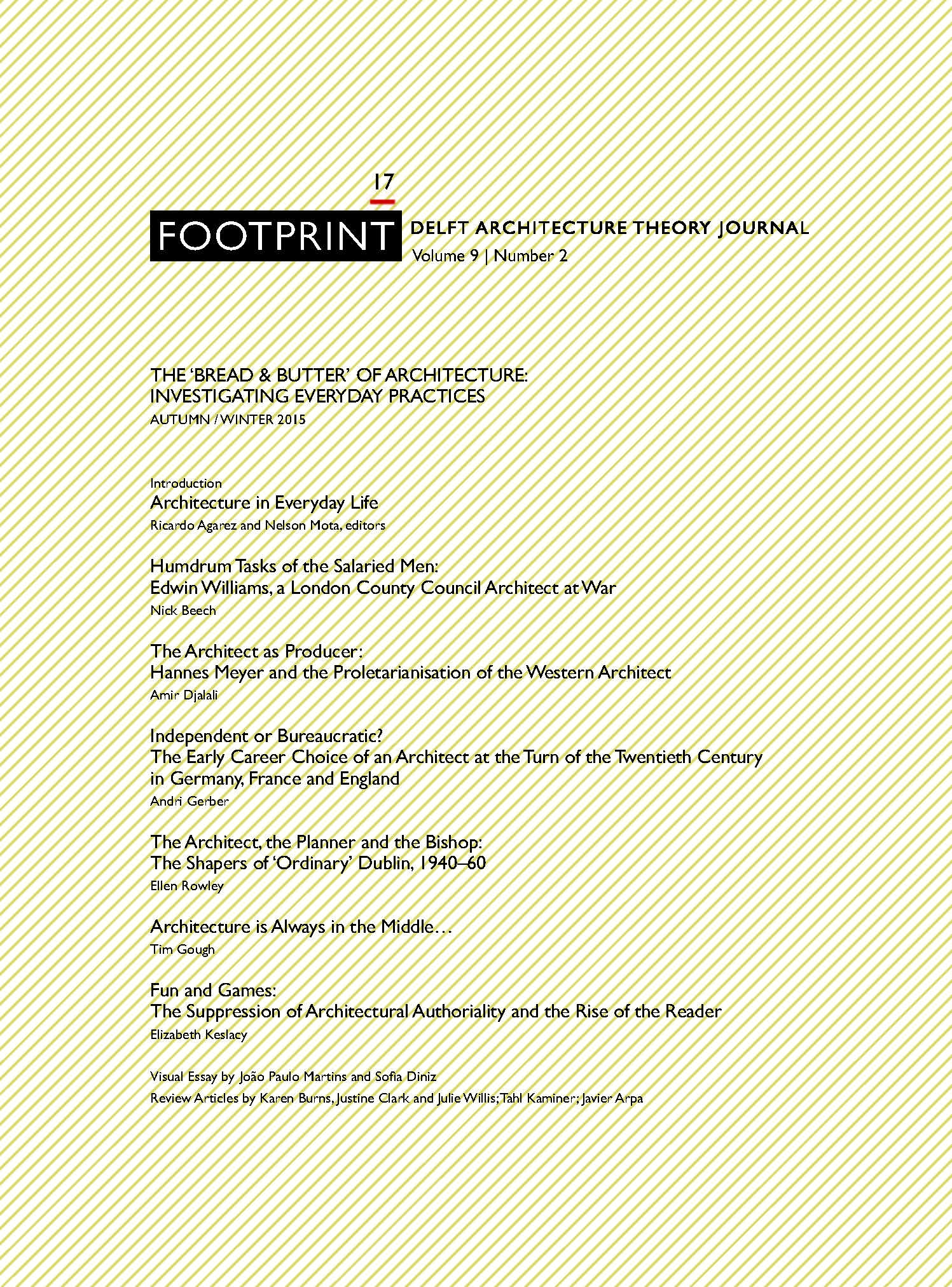Fun and Games: The Suppression of Architectural Authoriality and the Rise of the Reader
DOI:
https://doi.org/10.7480/footprint.9.2.869Abstract
Between the Roarkian caricature of the heroic modernist and the spectre of the contemporary starchitect, there was a period of resistance in which architectural authoriality came under fire. One of the most explicit challenges was issued through the use of gaming and simulation in both architectural education and practice in the 1960s and the 1970s, particularly in the work of Juan Pablo Bonta and Henry Sanoff - both of them architectural scholars, educators, and game enthusiasts. By tracing the importation of gaming and simulation techniques into architecture, this paper will show how architectural games sought to refigure the architect as a collaborative figure embedded in a network of experts, participants and constituents, and to modulate the architect’s design authority by foregrounding the contributions of viewer-interpreters to the creation of meaning. Situating their work within gaming precedents, from war and business games to urban planning gaming-simulations, I show how architecture games - particularly design games - worked to develop the architectural reader as a creative force, in some quarters going so far as to posit interpretation as the basis of design.
References
Barthes, Roland. Death of the Author. Translated by Stephen Heath. In Image, Music, Text, 142-48. New York: Hill and Wang, 1997.
Berkeley, Ellen Perry. 'The New Gamesmanship'. Architectural Forum (1968): 58-63.
Bloom, Harold. The Anxiety of Influence: A Theory of Poetry.< /i> London; New York: Oxford University Press, 1975.
Bonta, Juan Pablo. Architecture and Its Interpretation: A Study of Expressive Systems in Architecture. New York: Rizzoli, 1979.
———. Games in Design, Guest Lecture Series. Muncie. Lecture, 1972.
———.'Prologue'. JAE 33 (1-1979): 1.
———.'Simulation Games in Architectural Education'. JAE 33 (1-1979): 12-18.
Burden, Ernest E. Design Simulation: Use of Photographic and Electronic Media in Design and Presentation. New York: Wiley, 1985.
Duke, Richard D. Gaming-Simulation in Urban Research. East Lansing, MI: Institute for Community Development and Services, Continuing Education Service, Michigan State University, 1964.
———. 'Operational Gaming in Urban Planning'. In Selected Papers on Operational Gaming, edited by Allan G. Feldt, 1-19. Ithaca, NY: Division of Urban Studies, Center for Housing and Environmental Studies, Cornell University, 1966.
———. 'Origin and Evolution of Policy Simulation: A Personal Journey'. Simulation & Gaming 42 (3-2011): 342-58.
Eco, Umberto. The Open Work. Cambridge, MA: Harvard University Press, 1989.
———. The Role of the Reader: Explorations in the Semiotics of Texts.< /i> Bloomington: Indiana University Press, 1978.
Edwards, Paul N. The Closed World: Computers and the Politics of Discourse in Cold War America. Inside Technology. Cambridge, MA: MIT Press, 1996.
Feldt, Allan G. The Community Land Use Game: An Heuristic Gaming Device. Ithaca, NY: Division of Urban Studies, Center for Housing and Environmental Studies, Cornell University, 1968.
———. 'Experience with Simulation/Gaming 1960-2010'. Accessed 01 July 2015. http://www.clug.co/2013-fifty-years-of-simulationgaming.html.
Foucault, Michel. Language, Counter-Memory, Practice: Selected Essays and Interviews. Ithaca, NY: Cornell University Press, 1980.
Gough, Tim. 'Reception Theory of Architecture: Its Pre-History and Afterlife'. Architectural Theory Review 18 (3-2013): 279-92.
Green, Cedric. 'Design, Games and Language'. Build International 6 (6-1973): 617-33.
———. 'Playing Design Games'. JAE 33 (1): 22-26.
Halprin, Lawrence, and Jim Burns. Taking Part: A Workshop Approach to Collective Creativity. Cambridge: The MIT Press, 1974.
Iser, Wolfgang. The Act of Reading: A Theory of Aesthetic Response. Baltimore: Johns Hopkins University Press, 1978.
———. 'The Reading Process: A Phenomenological Approach'. New Literary History 3 (2-1972): 279-99.
Jauss, Hans Robert. Toward an Aesthetic of Reception. Theory and History of Literature. vol. 2. Minneapolis: University of Minnesota Press, 1982.
Jones, Wesley C. 'Architecture Games'. Log 19 (2010): 29-35.
Kelly, Burnham. 'Introduction'. In Selected Papers on Operational Gaming, edited by Allan G. Feldt, 1-7: Division of Urban Studies, Center for Housing and Environmental Studies, Cornell University, 1966.
Knoblauch, Joy Ruth. 'Going Soft: Architecture and the Human Sciences in Search of New Institutional Forms (1963-1974)'. PhD diss., Princeton University, 2012.
Kubo, Michael. 'The Idea of Anonymity in Postwar Architectural Practice'. Proceedings of the Creating_Making Conference, November 5-7, 2014 at the University of Oklahoma College of Architecture: 131-35.
Lawrence, Roderick J. 'Architectural Design Tools: Simulation, Communication and Negotiation.' Design Studies 14 (3-1993): 299-313.
Light, Jennifer. 'Taking Games Seriously'. Technology and Culture 49 (2-2008): 347-75.
Moore, Charles Willard. 'Design by Congregation: St. Matthew's Parish Church, Pacific Palisades, California'. Architectural Record 172 (2-1984): 94-103.
Moran, Brendan Daniel. 'Sociological Imagination and the City: Encounters between Architecture and Planning Education in America, 1933-1957'. PhD diss., Harvard University, 2009.
Ockman, Joan, and Avigail Sachs. '1940-1968: Modernism Takes Command'. In Architecture School: Three Centuries of Educating Architects in North America, edited by Joan Ockman and Rebecca Williamson, 122-59. Cambridge, MA: Washington, DC: The MIT Press; Association of Collegiate Schools of Architecture, 2012.
Pye, David. The Nature and Aesthetics of Design. New York: Van Nostrand Reinhold, 1978.
'Revolution in Architectural Education'. Progressive Architecture 48, (3-1967): 136-47.
Rosenblatt, Louise M. The Reader, the Text, the Poem: The Transactional Theory of the Literary Work. Carbondale: Southern Illinois University Press, 1978.
Sanoff, Henry. Design Games. Los Altos, CA: W. Kaufmann, 1979.
———. Designing with Community Participation. Stroudsburg, PA.: Dowden, Hutchinson & Ross, 1978.
Seitz, Sheila, and Courtney Uram. 'Gaming and Simulation'. In Instructional Design: Concepts, Methodologies, Tools and Applications, 1006-22. Hershey, PA: Information Science Reference, 2011.
Smith, Roger. 'The Long History of Gaming in Military Training'. Simulation & Gaming 41 (1-2010): 6-19.
Summers, Luis H. 'Operational Games in Architecture and Design'. JAE 33 (1-1979): 2-7.
Downloads
Published
Issue
Section
License
- Authors retain copyright and grant the journal right of first publication with the work simultaneously licensed under a Creative Commons Attribution License that allows others to share the work with an acknowledgement of the work's authorship and initial publication in this journal.
- Authors are able to enter into separate, additional contractual arrangements for the non-exclusive distribution of the journal's published version of the work (e.g., post it to an institutional repository or publish it in a book), with an acknowledgement of its initial publication in this journal.



